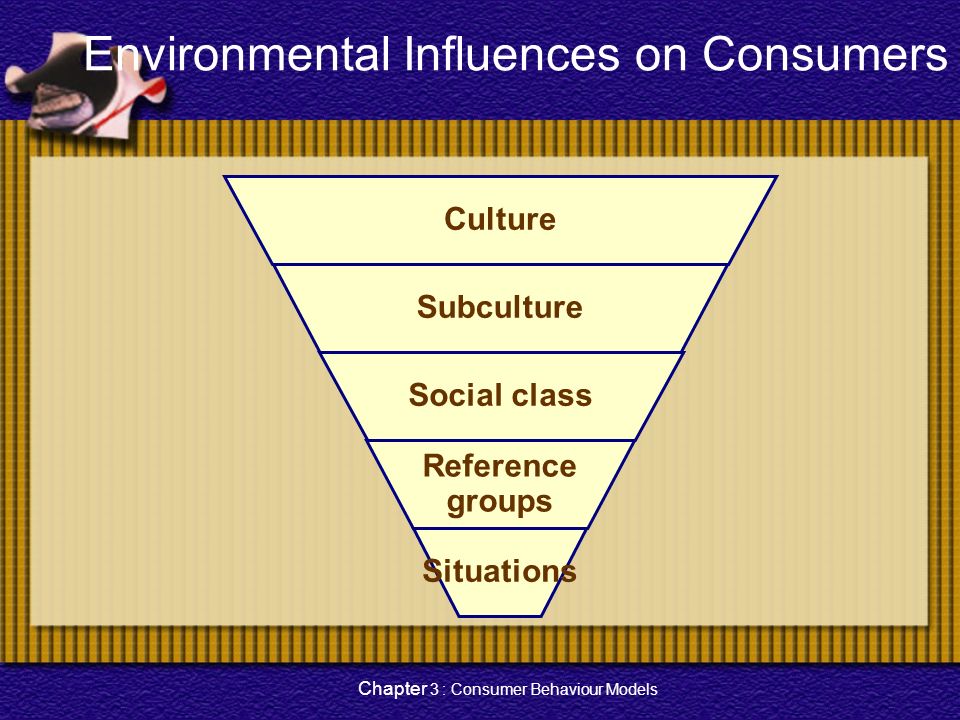Consumer Behaviour Models Ppt Download Free

Consumer Behaviour Models Chapter 3 Consumer Behaviour Models Chapter 3: Consumer Behaviour Models Chapter Objectives To understand the role consumer behaviour plays in the development and implementation of advertising and promotion programs. To understand the consumer decision-making process and how it varies for different types of purchase. Chapter 3: Consumer Behaviour Models Chapter 3: Consumer Behaviour Models Chapter Objectives To understand various internal psychological processes, their influence on consumer decision making, and implication for advertising and promotion. To recognize external factors such as culture, social class, group influences, and situational determinants and how they affect consumer behaviour. Chapter 3: Consumer Behaviour Models Consumer Decision Making Process Need Recognition Information Search Alternative Evaluation Purchase Decision Postpurchase Evaluation Chapter 3: Consumer Behaviour Models Consumer Decision Process Need Recognition Information Search Alternative Evaluation Purchase Decision Postpurchase Evaluation Motivation Perception Attitude Formation Integration Learning Decision Process Stages Psychological Processes Chapter 3: Consumer Behaviour Models Sources of Need Recognition Out of stock. Purchase decision is routine. Resolved by choosing familiar brand.
Dissatisfied with current state of product/service. Advertising is used to help consumers recognize need for new product.
Chapter 3: Consumer Behaviour Models Sources of Need Recognition New needs or wants. Created by life changes. Graduation, employment status, financial situation). Wants are desired but not essential. Related product purchase.
Purchase of a new product will most likely trigger purchase of accessories. New camera will require film). Chapter 3: Consumer Behaviour Models Sources of Need Recognition Marketer-induced recognition. Marketers’ encourage discontentment with current state or situation.
Brand switching is encouraged by sales promotion. New products. Innovative products may stimulate a need. Consumers may not see a need for what the marketer is selling. Chapter 3: Consumer Behaviour Models Examining Consumer Motivations Marketers recognize need recognition will influence the remainder of the decision process. To better understand consumer’s reasoning marketer’s devote considerable attention to motives.
Motives - factors that compel a consumer to take a particular action. Chapter 3: Consumer Behaviour Models Maslow’s Hierarchy of Needs Self-actualization needs (self-development, realization) Esteem needs (self-esteem, recognition, status) Social needs (sense of belonging, love) Safety needs (security, protection) Physiological needs (hunger, thirst) Chapter 3: Consumer Behaviour Models Market Research Methods In-depth interviews.
The consumer talks freely in an unstructured interview to obtain insights into his or her motives, ideas or opinions. Projective techniques. Methods allowing consumers to project values, motives, attitudes or needs on some external object. Chapter 3: Consumer Behaviour Models Market Research Methods Association tests.
Consumers respond with the first thing that comes to mind when presented with some verbal or pictorial stimulus. Focus groups. A group of consumers with similar backgrounds or interests discuss a product, idea or issue.
Consumer Behavior • 1. Consumer Behaviour • Based on concepts from Psychology Sociology Anthropology Marketing Economics • Why do we need to study Consumer Behaviour? Because no longer can we take the customer/consumer for granted. • Failure rates of new products introduced Out of 11000 new products introduced by 77 companies, only 56% are present 5 years later.
Only 8% of new product concepts offered by 112 leading companies reached the market. Out of that 83% failed to meet marketing objectives. • All managers must become astute analysts of consumer motivation and behaviour • Can Marketing be standardised? Because cross - cultural styles, habits, tastes, prevents such standardisation. • Unless Managements act The more successful a firm has been in the past, the more likely is it to fail in the future. Because people tend to repeat behaviour for which they have been rewarded.
- Reading out the text (convert to speech) in Dutch, English, French, German, Italian, Japanese, Korean, Portuguese, Russian and Spanish. Lec power translator world premium 15 multilingual v31r9 1. - Recognition of speech.
Consumer Markets and Consumer Buyer Behavior Topic Outline Model of Consumer Behavior Characteristics Affecting Consumer Behavior Types of Buying.